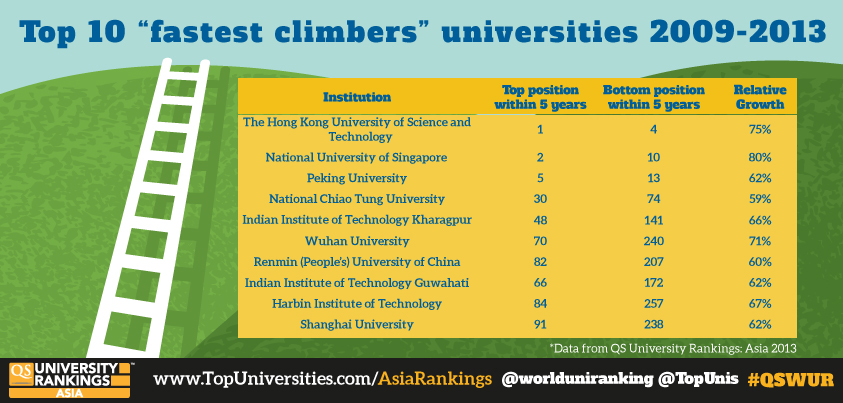Asia is full of fast-developing universities, but which have been most successful in improving their performance in the university rankings? Take a closer look at Asia’s top 10 climbers, based on change in position in the QS University Rankings: Asia over the past five years.
1. Hong Kong University of Science & Technology
HKUST entered the first edition of the QS University Rankings: Asia in 2009 in fourth place. That’s a highly respectable position in itself, but within two years HKUST had climbed to number one, where it remains – a 75% improvement in position. HKUST also tops this year’s Top 50 Under 50 – QS’s ranking of the world’s best universities under 50 years old.
2. National University of Singapore (NUS)
NUS has risen in five years from 10th place to 2= (joint with Hong Kong University) in the Asia ranking – an 80% improvement. The university is currently ranked 25th in the QS World University Rankings, and boasts a very strong reputation among both academics and employers – it’s now rated second in Asia among academics, and first by employers.
3. Peking University
China’s top ranked university, Peking has climbed from 13th to 5th place in the QS University Rankings: Asia in the last five years – an improvement of 62%. It’s currently ranked 44th in the world ranking, and is rated third in Asia by both academics and employers.
4. National Chiao Tung University
Taiwan’s oldest university, National Chiao Tung University has climbed from 74th place to its current 30th position. It’s not quite Taiwan’s highest placed, but it is gaining fast on National Taiwan University, which is currently 22nd.
5. Indian Institute of Technology Kharagpur
It’s not the highest ranked of the IITs but the Indian Institute of Technology Kharagpur has made the largest climb, from 141st to 48th. However, since reaching that position in 2011, it has lost a few places – it’s now 58th.
6. Wuhan University
China’s Wuhan University has improved from 240th to 70th, and is still making upwards progress – it climbed ten places between 2012 and 2013. There are still 11 Chinese universities ahead of Wuhan in the QS University Rankings: Asia, but if it keeps climbing at this pace it may soon overtake some of them!
7. Renmin University of China
Not quite as speedy as Wuhan in its rate of climb, but still pretty impressive, Renmin University of China (also known as People’s University of China) has risen from 207th to its current 82nd place. A strong reputation among graduate employers is one of its key strengths – it’s currently rated 37th in Asia by employers.
8. Indian Institute of Technology Guwahati
A little behind IIT Kharagpur, and climbing almost as fast, the Indian Institute of Technology Guwahati has improved from 172nd to 66th place in 2010. However, like many of the other IITs, it has lost some ground since then, ranking 89th in 2013.
9. Harbin Institute of Technology
Yet another fast climber from China, Harbin Institute of Technology improved from 257th to 84th – its 2012 position. However, it has lost ground again in the 2013 ranking, where it now stands at 123rd.
10. Shanghai University
Finally, a fifth Chinese university! The fact that 50% of this top 10 is Chinese is testament to the success of government schemes to raise the profile of China’s universities. Currently 91= (joint with Xiamen University), Shanghai University has climbed from 238th.
Employer reputation is one of the seven indicators used to create the QS University Rankings: Asia. See the full ranking and compare universities on all seven criteria >

